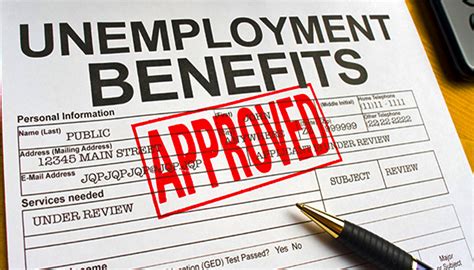Unemployment Insurance

Unemployment insurance is a vital social safety net, providing financial support to individuals who find themselves without work. It serves as a crucial mechanism to assist those facing unemployment, offering a temporary income while they search for new employment opportunities. This insurance program is designed to mitigate the financial strain caused by job loss and support individuals during a period of transition.
In the United States, the unemployment insurance system is a joint federal-state program, with each state administering its own unemployment insurance program within federally established guidelines. This system ensures a consistent safety net for workers across the nation while allowing for some flexibility at the state level. The federal government provides oversight and partial funding, while states manage the day-to-day operations, including eligibility determination, benefit calculation, and disbursement.
Despite its critical role, the unemployment insurance system faces various challenges, including changing economic landscapes, evolving workforce dynamics, and the need for sustainable funding. As we navigate an increasingly complex job market, understanding the intricacies of this system becomes ever more crucial. In this article, we will delve deep into the world of unemployment insurance, exploring its history, mechanics, and impact on individuals and the broader economy.
The Evolution of Unemployment Insurance: A Historical Perspective

Unemployment insurance has its roots in the early 20th century, a time marked by significant economic upheaval. The Great Depression of the 1930s brought widespread unemployment and highlighted the need for a social safety net to support those affected. It was against this backdrop that the concept of unemployment insurance gained traction, offering a potential solution to the economic challenges faced by millions.
The United States Federal Unemployment Tax Act (FUTA), enacted in 1935 as part of the Social Security Act, laid the foundation for the modern unemployment insurance system. FUTA established a federal-state partnership, providing the framework for states to develop their unemployment insurance programs. This legislation aimed to standardize unemployment insurance across the country while allowing states to adapt their programs to local needs.
Since its inception, the unemployment insurance system has undergone numerous revisions and updates to adapt to changing economic conditions and societal needs. Major revisions occurred in the 1950s and 1970s, with further enhancements in the 1990s and the early 2000s. These revisions addressed issues such as benefit levels, eligibility criteria, and the duration of benefits, ensuring the system remained responsive to the evolving landscape of work and unemployment.
One of the most significant expansions of unemployment insurance occurred in response to the 2008-2009 Great Recession. The American Recovery and Reinvestment Act (ARRA) of 2009 provided additional funding and extended the duration of unemployment benefits, recognizing the severity of the economic downturn and the prolonged periods of unemployment many individuals faced.
Today, unemployment insurance continues to play a critical role, providing a financial bridge for individuals between jobs. It serves as a vital component of the social safety net, offering stability and support during times of economic uncertainty.
How Unemployment Insurance Works: A Comprehensive Overview

The mechanics of unemployment insurance are intricate, involving a complex interplay of federal and state regulations, funding mechanisms, and eligibility criteria. At its core, the system aims to provide temporary financial assistance to individuals who have lost their jobs through no fault of their own.
Funding Sources
Unemployment insurance is primarily funded through a combination of federal and state taxes. Employers are required to pay federal unemployment taxes, also known as FUTA taxes, which are used to fund federal administrative costs and to provide loans to states for their unemployment insurance programs. Additionally, state unemployment taxes, or SUTA taxes, are collected by individual states to fund their unemployment insurance programs.
The FUTA tax rate is set at 6% on the first $7,000 of an employee's earnings. However, employers can claim a credit against this rate for payments made to their state unemployment fund, effectively reducing the federal tax rate to 0.6% for most employers. States, on the other hand, have varying tax rates and wage bases, which can be adjusted to meet the financial needs of their unemployment insurance programs.
Eligibility Criteria
Eligibility for unemployment insurance benefits is determined by a set of criteria established by each state. While there may be variations across states, some common requirements include:
- Employment Status: Individuals must have lost their job through no fault of their own. This typically excludes voluntary resignations or terminations due to misconduct.
- Work History: Most states require a minimum amount of work and earnings within a specified time frame, often referred to as a "base period," which is typically the first four of the last five completed calendar quarters before the application date.
- Active Job Search: To remain eligible, individuals must actively seek work and be available for suitable employment opportunities.
- Other Requirements: States may have additional criteria, such as registration with employment services or participation in reemployment services.
Benefit Calculation
The amount of unemployment insurance benefits an individual receives is calculated based on their previous earnings. Each state has its own method for calculating benefits, but generally, the calculation involves taking a percentage of the individual’s highest quarterly earnings during the base period.
For example, let's consider a state where the benefit calculation is based on the average of the highest quarterly wages in the base period. If an individual's highest quarterly earnings were $6,000, their weekly benefit amount might be calculated as $200 per week (approximately $6,000 / 30 weeks). However, states often have maximum and minimum weekly benefit amounts to ensure fairness and sustainability.
| State | Maximum Weekly Benefit | Minimum Weekly Benefit |
|---|---|---|
| California | $450 | $50 |
| New York | $504 | $50 |
| Texas | $535 | $102 |

Benefit Duration
The duration of unemployment insurance benefits varies by state and can be influenced by economic conditions. Typically, regular unemployment insurance benefits last for a specified number of weeks, often ranging from 12 to 26 weeks. However, during periods of high unemployment, states may extend the duration of benefits through federal programs like the Emergency Unemployment Compensation (EUC) program.
Disbursement and Administration
Unemployment insurance benefits are disbursed by states, usually through weekly or biweekly payments. These payments can be made through direct deposit, debit cards, or paper checks. The administration of the unemployment insurance program, including benefit determination, appeals processes, and fraud detection, is managed by state agencies.
The Impact of Unemployment Insurance: A Multi-Faceted Analysis
Unemployment insurance has a profound impact on the lives of individuals and the overall economy. It serves as a critical buffer against the financial hardships associated with job loss, providing a temporary income stream that allows individuals to meet their basic needs while they search for new employment opportunities.
Individual Benefits
For individuals, unemployment insurance can be a lifeline during a period of transition. It provides financial stability, allowing them to maintain their standard of living and avoid the potential pitfalls of debt or financial distress. This stability can be particularly crucial for individuals with families or other financial obligations.
Furthermore, unemployment insurance can act as a motivator for individuals to actively seek new employment. By providing a temporary income, it alleviates some of the immediate financial pressure, allowing individuals to take the time to find suitable and stable employment rather than accepting the first available job, which may not align with their skills or career goals.
Economic Impact
On a broader scale, unemployment insurance plays a significant role in stabilizing the economy during times of recession or economic downturn. By providing a source of income to those who have lost their jobs, it helps maintain consumer spending, which is a key driver of economic growth. This, in turn, can support businesses and prevent a further spiral of job losses.
Additionally, unemployment insurance can serve as a countercyclical tool, helping to smooth out economic fluctuations. During periods of high unemployment, the increased spending associated with unemployment benefits can stimulate the economy, creating a multiplier effect that benefits a wide range of industries.
Social Safety Net
Beyond its economic implications, unemployment insurance is a vital component of the social safety net. It provides a sense of security and support to individuals during a vulnerable period, helping to maintain their dignity and self-sufficiency. By offering a temporary safety net, it can prevent individuals from falling into long-term unemployment or financial hardship, which can have lasting negative effects on their well-being and future prospects.
Navigating the Unemployment Insurance System: A Step-by-Step Guide
For those facing unemployment, navigating the unemployment insurance system can be a complex process. Here is a step-by-step guide to help individuals understand their rights and responsibilities, and to ensure they receive the benefits they are entitled to.
Step 1: Understanding Eligibility
The first step is to determine your eligibility for unemployment insurance benefits. This involves reviewing your work history and earnings, as well as understanding the specific eligibility criteria set by your state. You can typically find this information on your state’s unemployment insurance website or by contacting your state’s unemployment office.
Step 2: Applying for Benefits
Once you’ve confirmed your eligibility, it’s time to apply for unemployment insurance benefits. The application process varies by state, but typically involves providing information about your work history, earnings, and the circumstances of your job loss. You may need to submit this information online, by mail, or in person at your state’s unemployment office.
Step 3: Waiting Period and Weekly Certifications
Most states have a one-week waiting period before you can receive unemployment insurance benefits. This waiting period does not impact your overall benefit amount or duration, but you will not receive benefits for this initial week of unemployment. After the waiting period, you will need to certify your eligibility on a weekly basis. This involves confirming that you are still unemployed, actively seeking work, and available for suitable employment opportunities.
Step 4: Receiving Benefits
Once your eligibility has been determined and you’ve started certifying your weekly status, you will begin receiving unemployment insurance benefits. These benefits are typically disbursed on a weekly or biweekly basis, and you will receive them until your benefit period ends or until you find new employment.
Step 5: Maintaining Eligibility
To maintain your eligibility for unemployment insurance benefits, you must continue to actively seek work and be available for suitable employment opportunities. This may involve registering with employment services, attending job fairs, or applying for jobs online. It’s crucial to keep records of your job search activities, as you may need to provide evidence of your efforts to your state’s unemployment office.
Step 6: Addressing Issues and Appeals
If you encounter any issues with your unemployment insurance claim, such as a denial of benefits or a reduction in your benefit amount, you have the right to appeal the decision. The appeals process varies by state, but typically involves a hearing where you can present your case and provide evidence to support your claim. It’s important to understand the appeals process in your state and to seek legal advice if needed.
Future Trends and Innovations in Unemployment Insurance

As the world of work continues to evolve, the unemployment insurance system must adapt to meet the changing needs of workers and the economy. Here are some future trends and potential innovations that could shape the landscape of unemployment insurance.
Technology Integration
The increasing adoption of technology in the unemployment insurance system can streamline processes, enhance efficiency, and improve the overall experience for claimants. This includes the use of online portals for application and certification, as well as the integration of data analytics to identify potential fraud or errors in benefit calculations.
Expanded Eligibility Criteria
There is ongoing debate about expanding the eligibility criteria for unemployment insurance to include a broader range of workers. This could include gig workers, independent contractors, and those in the informal economy. Such an expansion would reflect the changing nature of work and ensure that more individuals have access to the financial support they need during periods of unemployment.
Enhanced Reemployment Services
Unemployment insurance programs could place greater emphasis on providing reemployment services to help individuals quickly transition back into the workforce. This could involve offering more robust job training and placement programs, as well as personalized career counseling to support individuals in finding stable and suitable employment.
Sustainable Funding Models
Ensuring the long-term sustainability of unemployment insurance programs is a critical challenge. This involves exploring innovative funding models, such as the use of private-public partnerships or the development of new tax structures, to ensure that the system remains financially viable while continuing to provide vital support to those in need.
Global Best Practices
Looking beyond national borders, there is an opportunity to learn from and adapt global best practices in unemployment insurance. This could involve studying the success stories of other countries in managing their unemployment insurance programs, including their approaches to funding, eligibility, and benefit structures.
How often are unemployment insurance benefits paid?
+Unemployment insurance benefits are typically paid on a weekly or biweekly basis. The frequency of payments can vary by state, with some states opting for weekly payments while others use a biweekly schedule.
What happens if I find a new job while receiving unemployment insurance benefits?
+If you find a new job while receiving unemployment insurance benefits, you are generally expected to notify your state’s unemployment office immediately. Depending on the circumstances and the laws in your state, you may be eligible to continue receiving benefits for a certain period after you start your new job. However, it’s important to understand the specific rules and regulations in your state regarding this situation.
Can I receive unemployment insurance benefits if I quit my job voluntarily?
+In most cases, no. Unemployment insurance benefits are typically reserved for individuals who have lost their jobs through no fault of their own, such as due to a layoff or company closure. If you voluntarily quit your job, you may not be eligible for unemployment insurance benefits, as it is generally assumed that you have chosen to leave the employment relationship.



